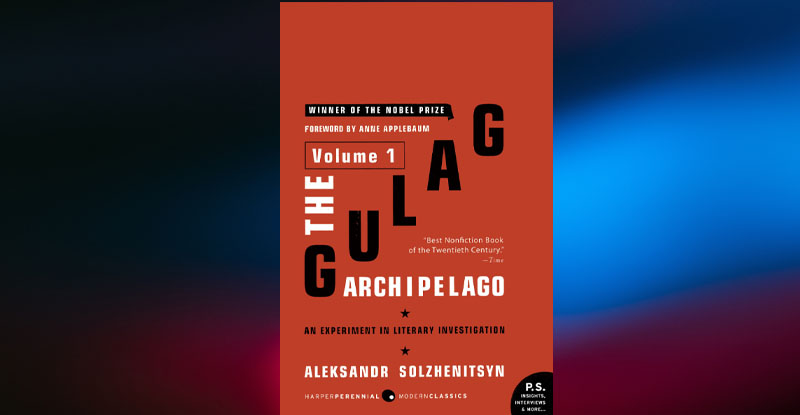Reviewed by Scott Sturman, USAFA ’72
Member of the STARRS Board of Advisors
“The Gulag Archipelago,” published in 1973, represents the Nobel Prize winning masterpiece of Aleksandr Solzhenitsyn, who spent eight years as a political prisoner in the Gulag. The 2000 page, three volume tome has been described as the 20th century’s foremost non-fiction book and describes the Soviet forced labor penal system from its inception in 1918 until its demise in 1956.
In 1918, a year after assuming power, Lenin initiated concentration camps based on slave labor under the guise of the oft used euphemism “work will set you free.” By 1924 Stalin discarded all pretense and developed a highly organized, brutal apparatus whose sole purpose was punishment.
Millions died and life expectancy measured less than two weeks in hellholes like the Kolyma mines, as prisoners starved, froze, and worked themselves to death. During WWII the death rate in the Gulag was 1% per day.
How did this abominable system come to be? The Soviets employed the ruthless tactics of the Cheka and NKVD, the secret police agencies, to terrorize the population. Without freedom of the press, the unarmed citizenry were at the mercy of a court and police system where judge, prosecutor, and defender were one and the same. Guilt by association and denunciation were commonplace and such charges could not be disputed. Children were indoctrinated by the Party and educational establishment to turn on parents; the use of stool pigeons and informants was ubiquitous.
Destruction of all traditional norms and organizations were undermined by the promulgation of class warfare. Using an all pervasive propaganda machine, the Communists scapegoated members of the church, the intelligentsia (engineers were a favorite target), and the Kulaks, the ambitious, land owning farmers. The promotion of pseudoscience, like Lysenko’s bizarre theories of genetics, were used to justify collectivization and slaughter of the independent agrarian class.
Later a favorite target of abuse was returning Soviet soldiers, who had defeated the Nazis on the Eastern Front. Expecting a heroes welcome, they were often given ten year or life sentences for the crime of having witnessed what life was like outside of the Soviet Union. Stalin’s paranoia was so great that he could not risk the Soviet people hearing first hand accounts of prosperity and freedoms of the West that even during WWII shamed the USSR.
Throughout the Communist years, grand public works projects served as means to demonstrate the industrial might of the Soviet Union and acumen of its leaders.
Stalin scoffed at the suggestion of using machines, when men and women were available to provide the back breaking labor. The Volga Canal, a project that can be compared to the Suez Canal, was built with this philosophy and where wood substituted for steel and earth for cement.
With engineers relegated to the position of common laborers, technical positions were awarded by social class with no consideration of merit. The projects technically failed but served the purpose of subjugating millions of those wrongfully accused of crimes against the state.
In the Great Purge of 1937 Stalin turned on his fellow Communists, who he perceived as a threat to his control. Always one to exterminate potential rivals, he dealt his wrath on the Communist Party.
So powerful was the Stalin Cult and fear he engendered, that Solzhenitsyn describes loyal, hardcore Communists questioning their ideologic purity and excusing Stalin for imprisonment.
In their minds how could the 5 foot 4 inch, pocked faced megalomaniac be anything but the embodiment of perfection? This blindness and self hate did not occur with common prisoners, who never doubted their innocence.
Solzhenitsyn was charged as a political subversive at the conclusion of WWII when Soviet intelligence agents discovered a letter he had written which was critical of Stalin. His guilt was a foregone conclusion – only the length of his sentence and prison locations were to be determined.
Like all “Politicals” he was beaten, starved, sleep deprived, and forced to sign a bogus confession. Throughout his incarceration he was subjected to abuse at the hands of common criminals who were imprisoned with the political detainees. These murders, thieves, charlatans, and rapists were used to harass the vast majority of other prisoners whose crimes were political.
Since the reprehensible crimes of criminals could be excused because of their low class, they were free to engage in a rein of terror against prisoners from the bourgeoisie.
A prison system is only possible if guards can be found to administer it. These capricious souls were selected for their lack of moral character. The qualities of stupidity, corruption, sadism, laziness, and perversion were required to work people to death, to shoot them on sight for no provocation, to rip children from their parents for no other reason than
belonging to the same family, and to destroy the hope and humanity of prisoners. Guards were paid three times the salary of those of equivalent rank in the military, given extra provisions, and told they were Stalin’s elite. And yet, the Gulag cannot be justified economically, for it bred laziness and low productivity, and spawned the misconception that supply and demand were unrelated.
After Solzhenitsyn served his sentence, he remained in external exile, which required work permits, frequent reporting to authorities, and keeping his manuscripts secret.
Despite his suffering, her professed himself a better person for having endured his personal chaos. He acknowledged that his hubris and lack of empathy gave way to a more introspective and courageous person. He found strength in religion and noted those who survived the camps were often those of faith.
Solzhenitsyn memorialized those who suffered and perished in the Gulag. He discussed all the extremes of human emotion and conduct- from those who attempted escape at every chance, to cads who stabbed their fellows in the back, to those who never gave up hope.
He gave us a window into history to avoid the fate of millions of Russians, if we are wise enough to heed his words and warnings.








Leave a Comment